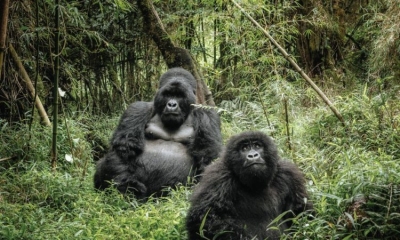
The Bwindi Impenetrable National Park is one of the very few places in the world to spot the mountain gorilla in the wild. Indicative of a healthy habitat, the number of this endangered species there has increased in the last few years.
Situated in the southwest part of Uganda and bordering the Democratic Republic of Congo, the Bwindi Impenetrable National Park spans more than 320 sq.km. The forests in the Park are believed to be the remaining areas of what was once a very large forest region covering vast areas of western Uganda, Rwanda, Burundi, and eastern parts of the Democratic Republic of Congo. With more than 200 tree species and 100 fern species, this biodiversity hotspot is said to have one of the largest number of tree species at this altitude in this part of the continent. Not surprisingly, the Park hosts more than 300 species of birds, including those that are endemic to the region. The place also nurtures several species of butterflies and mammals. Most importantly, it is one of the three places in the world where mountain gorillas can be found, and is home to nearly half the world’s population of these gorillas. Declared a UNESCO World Heritage Site in 1994, the Park thrives primarily on community support and ecotourism. However, it is threatened by development activities, habitat loss, and hunting of gorillas and chimpanzees.
Wildlife
Some of the birds that can be spotted in the Park are francolins, owls, nightjars, bee-eaters, tinkerbinds honeyguides, woodpeckers, shrikes warblers flycatchers, tits, sunbirds, storks weavers, orioles, wagtails seedeaters, broadbills, cuckooshrikes, swallows, robins, cuckoos barbets, trogons, kingfishers, pigeons, doves, and buzzards Baboons. monkeys, squirrels, antelopes such as marshbuck, chimpanzees, elephants, and mountain gorillas are among the mammals found in the region.
Mountain gorilla facts
- Found only in three countries today-Rwanda Uganda, and the Democratic Republic of Congo-the mountain gorilla is a subspecies of the eastern gorilla.
- It is also called the silverback gorilla since the adult male has a silvery patch of hair on its back. This mammal can grow up to six feet and weigh even more than 200 kg. Despite its imposing size, the gorilla is a gentle, calm, and non-aggressive animal that gets aggressive only when disturbed or threatened
- The mountain gorilla’s food is predominantly vegetarian, consisting of shoots, roots, fruits, etc. But it will also help itself to insects. This mammal is usually found in troops led by an adult male and comprising younger males females, and their offspring. Young gorillas spend a lot of their time playing much like their human counterparts!
- Though its population is said to be increasing, thanks to consistent conservation efforts, the International Union for Conservation of Nature has listed the animal as endangered since it continues to be threatened by habitat destruction and hunting.
Threats
According to the International Union for Conservation of Nature, the conservation outlook for this site has been assessed as “good with some concerns in the latest assessment cycle (2020). While globally several endangered species continue to see decline in numbers, the mountain gorilla population has seen a slight in the last few years. In fact gorilla-based tourism in the region has helped the community living around it. But the place is still not without its share of concerns. As a thickly populated region, human-animal conflict is a reality, especially during crop raids by wildlife. Communities using forest produce too are a direct threat to the natural habitat and its inhabitants. However, the threat to the place overall is perceived as low.
Picture Credit : Google




